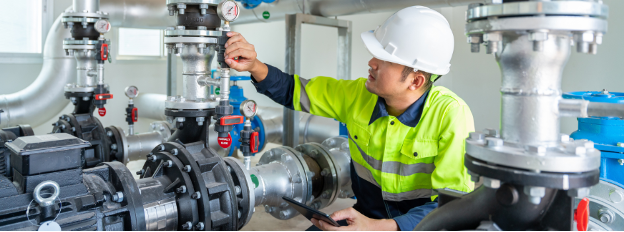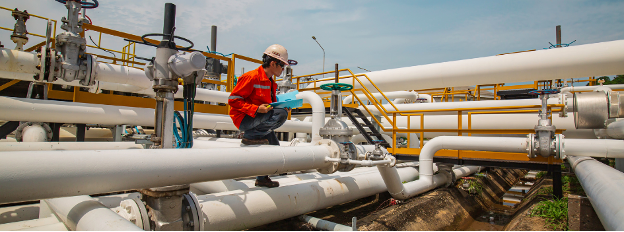
Different Types of Pump Tests You Should Know About
As seasoned pump experts with years of experience in the field, DXP understands the importance of proper pump testing protocols. Ensuring that industrial pumps function efficiently is important for maintaining optimal performance and preventing breakdowns. In this guide, we will explain the different types of pump tests you may come across.
Pump Vibration Test
During a vibration test, special sensors are typically attached to key pump components, such as the motor, impeller, or shaft, to measure the amplitude, frequency, and direction of vibrations. By analyzing the vibration data collected, maintenance professionals can identify abnormal vibration patterns and diagnose underlying problems affecting the pump’s performance.
The results of a pump vibration test can help maintenance teams determine the pump’s condition, predict potential failures, and schedule timely repairs or maintenance activities to prevent costly downtime and equipment damage. Regular pump vibration monitoring is a proactive approach to ensure the reliability, efficiency, and longevity of pumps in various industrial applications.
Pump Cavitation Test
During a cavitation test, technicians typically monitor parameters like suction pressure, discharge pressure, flow rate, and pump performance while the pump is in operation. By analyzing these measurements, maintenance professionals can identify signs of cavitation, such as unusual noise, decreased performance, or vibrations. Visual inspections may also be conducted to check for physical signs of cavitation damage, such as pitting on impeller blades or erosion on pump surfaces.
The results of a cavitation test can help maintenance teams determine if the pump is operating within safe parameters or if adjustments are needed to prevent cavitation-related issues. Proper maintenance — adjusting operating conditions, repairing damaged components, installing cavitation-resistant materials, etc. — can help mitigate the risks associated with cavitation and prolong the life of the pump system. Regular cavitation testing is essential for ensuring the reliability, efficiency, and longevity of industrial pumps in various applications.
Seal Leak Test
A leak test is a procedure used to assess the integrity of the seals that prevent fluid leakage from the pump. This test typically involves pressurizing the pump housing with a test fluid while monitoring for any signs of leakage around the seals. By detecting leaks early, maintenance can be scheduled to replace worn or damaged seals, preventing potential environmental hazards, product contamination, or equipment failure. Additionally, a seal leak test ensures the reliability and safety of the pump operation.

Flow Rate Test
In a flow rate test, engineers set up the pump within a controlled testing environment equipped with flow meters, pressure gauges, and other relevant instrumentation. The pump is connected to a water source or the fluid it’s intended to handle in the actual application.
The test begins by gradually increasing the pump’s operating speed or adjusting the discharge pressure to simulate different working conditions. As the pump operates, technicians monitor and record the flow rate at each specified condition. This data helps create a performance curve illustrating the pump’s output capacity across its operating range.
By analyzing this curve, engineers can verify if the pump meets the required flow rates, identify any inefficiencies or deviations from expected performance, and make necessary adjustments or repairs to optimize its operation. Additionally, flow rate testing ensures that the pump performs reliably and consistently under various operating conditions, meeting the demands of its intended industrial application.
Net Positive Suction Head Test
An NPSH test determines if a pump has adequate suction pressure to prevent cavitation. During the test, technicians measure the NPSH available (NPSHa) by considering the pressure at the pump inlet, liquid properties, and system design. They compare this value to the NPSH required (NPSHr) by the pump manufacturer to ensure that it operates efficiently and without cavitation, which can lead to damage and reduced performance.
Overall, conducting NPSH tests helps maintain pump reliability and performance in various industrial applications.
Conducting these various types of pumps tests can help identify potential issues early, prevent costly downtime, and ensure optimal performance and longevity of the equipment. Regular maintenance and testing are key to maximizing the efficiency and reliability of your pumps.
Explore DXP’s Rotating Equipment and Pumping Solutions
For high-quality industrial pumps and rotating equipment, trust DXP. Our wide range of products and expert services are designed to meet your industrial needs. Contact us today to learn more about how DXP’s pump solutions can help optimize your operations and keep your pumps running smoothly.
Remember, a well-maintained pump is a reliable pump. Invest in quality equipment and follow proper testing protocols to ensure the longevity and efficiency of your process pumps. Trust DXP for all your industrial equipment needs.

